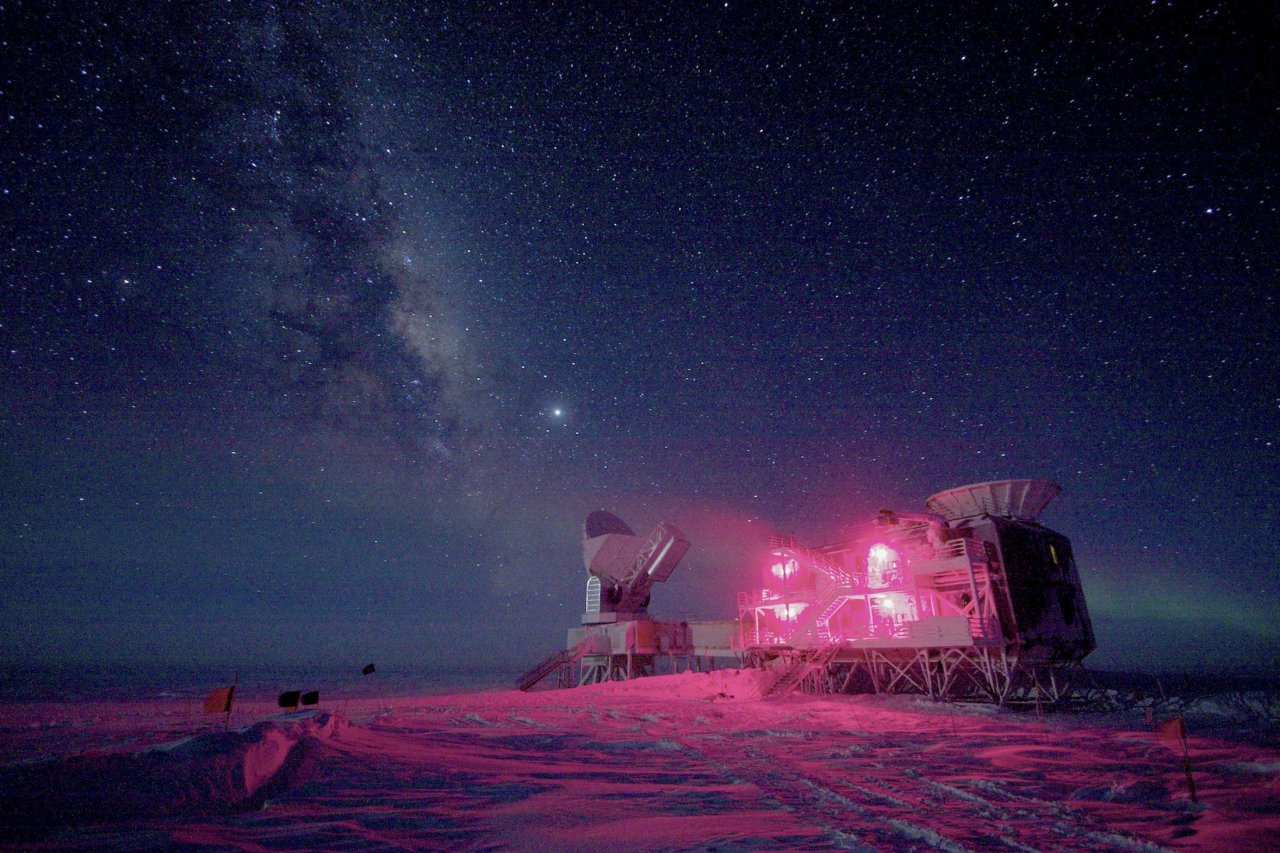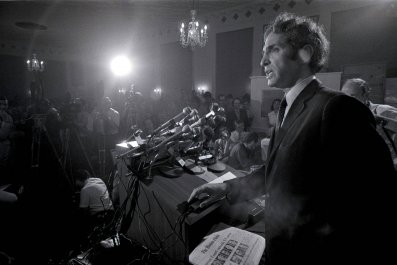"Extraordinary claims require extraordinary evidence" was a phrase made popular by the late American astronomer Carl Sagan. But when it comes to the stunning announcement earlier this year of gravity waves that marked the birth pangs of the universe, it has now become clear that we are going to have to wait at least until October before scientists will have a chance to amass enough extraordinary evidence.
Only then will we find out if that cosmic bombshell truly is worthy of a clutch of Nobel prizes, as global headlines claimed a few months ago, or if it was a damp squib. Whatever happens, however, the saga has revealed a profound challenge facing theorists attempting to chart the origin, evolution and future of the universe.
The story dates back to March, when astrophysicists announced that a telescope near the South Pole, known as the Background Imaging of Cosmic Extragalactic Polarisation 2 (BICEP2), had observed a subtle twisting pattern in a map of the polarisation of the faint afterglow of the Big Bang of creation, known as the cosmic microwave background. If light is polarised it means a majority of its component electromagnetic waves have an electric field that is oscillating along a certain direction as they travel towards the Earth. In this case, mapping the polarisation direction over a patch of sky, they looked for a special twist pattern in the ancient light called 'B-modes,' then found it. At the time of the announcement, the swirly patterns were not published in a journal and subjected to the scrutiny of peer review, but announced by John Kovac, Jamie Bock, Clem Pryke, Chao-Lin Kuo and colleagues during a news conference at the Harvard-Smithsonian Centre for Astrophysics in Cambridge, Massachusetts, and presented in a draft paper online.
The swirls caused a sensation, were hailed as being bigger than the discovery of the Higgs particle, and were said to herald a new era in physics. As Max Tegmark of the Massachusetts Institute of Technology, MIT, remarked, "if it holds up, it will go down as one of the greatest discoveries in the history of science".
One reason for the global headlines was that the twisting pattern seen by the BICEP2 team marked the first time that astrophysicists had spotted direct evidence of gravitational waves. First predicted by Albert Einstein, who spoke about gravitational fields that propagate with the speed of light in 1916, only indirect evidence had previously emerged (from the slowing down of the rotation of binary pulsars, superdense neutron stars). To generate gravitational waves requires a cataclysmic event, even by the cosmic standards of the universe. For example, they can be made in the collision between black holes but, even so, the wavelengths in this case would be tiny compared with those seen by BICEP2. Instead, they gave support to an idea known as inflation, put forward by in 1980 by Alan Guth, currently a professor at MIT and refined by -others.
At its most basic, the theory of inflation says that at its birth some 13.8 billion years ago our universe was once smaller than an atom, then grew so mind-bogglingly rapidly in size that it could produce and stretch out gravitational waves of the kind that BICEP2 had observed: only primordial gravitational waves can imprint this pattern, and only then if they have been amplified by inflation.
This evidence of what the team called the 'first tremors of the Big Bang' thrilled many theoretical physicists because these primordial waves provided an umbilical cord between the world of the very small, ruled by quantum mechanics, with the very big, ruled by Einstein's theory of gravity, general relativity. A grander union of the two theories into a single theory of everything – so called quantum gravity – would be the next logical step for a merger between particle physics and cosmology that has been one of the most distinctive features of recent science.
Still more consequences ripple out of the extraordinary concept of inflation. What we normally think of as the universe – all the stuff that we can observe with telescopes – is just one pocket where inflation happened to grind to a halt to allow matter to condense, galaxies and stars to form, and humans and other life to evolve.
Elsewhere, beyond the familiar cosmos we can see, space and time may still be inflating, so that, according to some models of inflation, other "bubble" universes are popping into being with completely different properties. This has another implication. By potentially backing the radical idea of a multiverse, BICEP2's results mark the death knell for alternative cosmic visions, cyclic "big bounce" models of the universe where time has no beginning or end and the cosmos endlessly dies and rises from its ashes.
But there was a problem, one that has been raised repeatedly since the original announcement: the signals detected by BICEP2 are masked by distortions caused by the light's passage through clusters of galaxies, and through dust clouds in the Milky Way. Carlos Frenk, Professor of Fundamental Physics at Durham University, UK, was uneasy about the original claims because the confusing signals are much larger than the tell-tale signal that reveals the ripples. He was "suspicious from day one because the signal seemed implausibly large".
To strip away the distortions, the BICEP2 team used various ways to examine the role of dust in their results including, somewhat cheekily, data presented at an April 2013 conference by their rivals from the European Space Agency (ESA). Their PowerPoint slide gave preliminary data on how dust particles polarise light in space from ESA's Planck telescope, which has been mapping tiny differences in microwave radiation left over from the Big Bang its spot on a 'LaGrange point,' a gravitational stable position some 1.5 million kilometres from Earth.
But in recent weeks it has been claimed that the Harvard scientists missed that the Planck slide had averaged the effects of dust in the Milky Way along with dust far beyond our own galaxy, leading them to underestimate how much this cosmic lint naturally twists light. Another problem is that synchrotron radiation, a glow generated by electrons moving around galactic magnetic fields within our own galaxy, can also produce these polarised twists. "The BICEP2 team claimed to have done the foreground subtraction very carefully but perhaps they were not careful enough," says Frenk.
A reanalysis by a team at Princeton University and the nearby Institute for Advanced Study concluded that the seductive swirls could be the result mostly or entirely of foreground effects, without any contribution from gravitational waves. Alan Guth, the cosmologist who first proposed the concept of cosmic inflation in 1980, had thought the initial BICEP2 results were secure but, in the light of the kerfuffle, now says that "the situation has changed". Paul Steinhardt of Princeton University, who did early work on inflation, went further and remarked that "serious flaws in the analysis have been revealed that transform the sure detection into no detection. The search for gravitational waves must begin anew".
The Planck satellite team is gearing up to release their analysis of dust in the same region probed by BICEP2 and later this year, in October, present their own analysis of B-mode polarisation. "They will do the best possible job with current and foreseen data to characterise these foregrounds – a large fraction of the Planck effort has gone precisely into this," says Frenk. "I am confident that these Planck data will resolve the issue conclusively. Until then, one needs to be cautious and sceptical."
There are other research projects able to spot ancient gravitational waves among noisy signals, such as the South Pole Telescope, POLARBEAR experiment in the Atacama Desert of northern Chile, or the Keck Array, a suite of telescopes at the South Pole, which is led by the scientists behind BICEP2. These could also help clear up the controversy.
It remains a possibility that that, though not as prominent as they had thought, the BICEP2 project really had seen a signature of gravitational waves. Even so, their original data may not constitute the extraordinary evidence that is required to advance science, and fall short of that required to pop champagne corks at a Nobel celebration in Stockholm.
But there is a deeper issue, one raised in the journal Nature by Paul Steinhardt, a proponent of the cyclic universe, who is concerned that the reason they give is "the inflationary paradigm is so flexible that it is immune to experimental and observational tests". Steinhardt, who does not see eye-to-eye with Frenk and Tegmark on this issue, finds this flexibility alarming.
Inflation predicts not one universe but a multiverse with an infinite number of bubbles, in which the cosmic and physical properties vary locally from bubble to bubble and where everything that can physically happen does indeed happen, and an infinite number of times. That is why some proponents of inflation insist that the theory remains equally valid, whether or not gravitational waves are detected. In other words, the theory lies beyond the reach of evidence, no matter how extensive and extraordinary. Is cosmology undergoing a step change, one away from the enlightenment of the scientific method towards the myth and legend of long ago?































